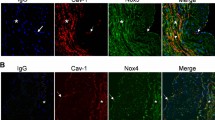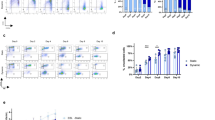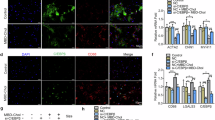Abstract
Aim:
To investigate the mechanisms of anti-atherosclerotic action of ezetimibe in rat vascular smooth muscle cells (VSMCs) in vitro.
Methods:
VSMCs of SD rats were cultured in the presence of Chol:MβCD (10 μg/mL) for 72 h, and intracellular lipid droplets and cholesterol levels were evaluated using Oil Red O staining, HPLC and Enzymatic Fluorescence Assay, respectively. The expression of caveolin-1, sterol response element-binding protein-1 (SREBP-1) and ERK1/2 were analyzed using Western blot assays. Translocation of SREBP-1 and ERK1/2 was detected with immunofluorescence.
Results:
Treatment with Chol:MβCD dramatically increased the cellular levels of total cholesterol (TC), cholesterol ester (CE) and free cholesterol (FC) in VSMCs, which led to the formation of foam cells. Furthermore, Chol:MβCD treatment significantly decreased the expression of caveolin-1, and stimulated the expression and nuclear translocation of SREBP-1 in VSMCs. Co-treatment with ezetimibe (3 μmol/L) significantly decreased the cellular levels of TC, CE and FC, which was accompanied by elevation of caveolin-1 expression, and by a reduction of SREBP-1 expression and nuclear translocation. Co-treatment with ezetimibe dose-dependently decreased the expression of phosphor-ERK1/2 (p-ERK1/2) in VSMCs. The ERK1/2 inhibitor PD98059 (50 μmol/L) altered the cholesterol level and the expression of p-ERK1/2, SREBP-1 and caveolin-1 in the same manner as ezetimibe did.
Conclusion:
Ezetimibe suppresses cholesterol accumulation in rat VSMCs in vitro by regulating SREBP-1 and caveolin-1 expression, possibly via the MAPK signaling pathway.
Similar content being viewed by others
Log in or create a free account to read this content
Gain free access to this article, as well as selected content from this journal and more on nature.com
or
References
Yan P, Xia C, Duan C, Li S, Mei Z . Biological characteristics of foam cell formation in smooth muscle cells derived from bone marrow stem cells. Int J Biol Sci 2011; 7: 937–46.
Sudhop T, Lutjohann D, Kodal A, Igel M, Tribble DL, Shah S, et al. Inhibition of intestinal cholesterol absorption by ezetimibe in humans. Circulation 2002; 106: 1943–8.
Tsunoda T, Nozue T, Yamada M, Mizuguchi I, Sasaki M, Michishita I . Effects of ezetimibe on atherogenic lipoproteins and glucose metabolism in patients with diabetes and glucose intolerance. Diabetes Res Clin Pract 2013; 100: 46–52.
Davis HR Jr, Lowe RS, Neff DR . Effects of ezetimibe on atherosclerosis in preclinical models. Atherosclerosis 2011; 215: 266–78.
Davis HR Jr, Compton DS, Hoos L, Tetzloff G . Ezetimibe, a potent cholesterol absorption inhibitor, inhibits the development of atherosclerosis in ApoE knockout mice. Arterioscler Thromb Vasc Biol 2001; 21: 2032–8.
Gomez–Garre D, Munoz-Pacheco P, Gonzalez-Rubio ML, Aragoncillo P, Granados R, Fernandez-Cruz A . Ezetimibe reduces plaque inflammation in a rabbit model of atherosclerosis and inhibits monocyte migration in addition to its lipid-lowering effect. Br J Pharmacol 2009; 156: 1218–27.
Rothberg KG, Heuser JE, Donzell WC, Ying YS, Glenney JR, Anderson RG . Caveolin, a protein component of caveolae membrane coats. Cell 1992; 68: 673–82.
Pavlides S, Gutierrez-Pajares JL, Danilo C, Lisanti MP, Frank PG . Atherosclerosis, caveolae and caveolin-1. Adv Exp Med Biol 2012; 729: 127–44.
Chang SH, Feng D, Nagy JA, Sciuto TE, Dvorak AM, Dvorak HF . Vascular permeability and pathological angiogenesis in caveolin-1-null mice. Am J Pathol 2009; 175: 1768–76.
Drab M, Verkade P, Elger M, Kasper M, Lohn M, Lauterbach B, et al. Loss of caveolae, vascular dysfunction, and pulmonary defects in caveolin-1 gene-disrupted mice. Science 2001; 293: 2449–52.
Hu Q, Zhang XJ, Liu CX, Wang XP, Zhang Y . PPARgamma1-induced caveolin-1 enhances cholesterol efflux and attenuates atherosclerosis in apolipoprotein E-deficient mice. J Vasc Res 2010; 47: 69–79.
Luo DX, Cao DL, Xiong Y, Peng XH, Liao DF . A novel model of cholesterol efflux from lipid-loaded cells. Acta Pharmacol Sin 2010; 31: 1243–57.
Smart EJ, De Rose RA, Farber SA . Annexin 2-caveolin 1 complex is a target of ezetimibe and regulates intestinal cholesterol transport. Proc Natl Acad Sci U S A 2004; 101: 3450–5.
De Rose RA, Farber SA . Retraction for Smart et al. Annexin 2-caveolin 1 complex is a target of ezetimibe and regulates intestinal cholesterol transport. Proc Natl Acad Sci U S A 2013; 110: 797.
Bennett MK, Seo YK, Datta S, Shin DJ, Osborne TF . Selective binding of sterol regulatory element-binding protein isoforms and co-regulatory proteins to promoters for lipid metabolic genes in liver. J Biol Chem 2008; 283: 15628–37.
During A, Dawson HD, Harrison EH . Carotenoid transport is decreased and expression of the lipid transporters SR-BI, NPC1L1, and ABCA1 is downregulated in Caco-2 cells treated with ezetimibe. J Nutr 2005; 135: 2305–12.
Horton JD, Goldstein JL, Brown MS . SREBPs: activators of the complete program of cholesterol and fatty acid synthesis in the liver. J Clin Invest 2002; 109: 1125–31.
Daemen S, Kutmon M, Evelo CT . A pathway approach to investigate the function and regulation of SREBPs. Genes Nutr 2013; 8: 289–300.
Luo DX, Xia CL, Li JM, Xiong Y, Yuan HY, Tang ZW, et al. Static pressure accelerates ox-LDL-induced cholesterol accumulation via SREBP-1-mediated caveolin-1 downregulation in cultured vascular smooth muscle cells. Biochem Biophys Res Commun 2010; 403: 52–8.
Yuan HY, Kuang SY, Zheng X, Ling HY, Yang YB, Yan PK, et al. Curcumin inhibits cellular cholesterol accumulation by regulating SREBP-1/caveolin-1 signaling pathway in vascular smooth muscle cells. Acta Pharmacol Sin 2008; 29: 555–63.
Muraoka T, Aoki K, Iwasaki T, Shinoda K, Nakamura A, Aburatani H, et al. Ezetimibe decreases SREBP-1c expression in liver and reverses hepatic insulin resistance in mice fed a high-fat diet. Metabolism 2011; 60: 617–28.
Mulay V, Wood P, Manetsch M, Darabi M, Cairns R, Hoque M, et al. Inhibition of mitogen-activated protein kinase Erk1/2 promotes protein degradation of ATP binding cassette transporters A1 and G1 in CHO and HuH7 cells. PLoS One 2013; 8: e62667.
Roth G, Kotzka J, Kremer L, Lehr S, Lohaus C, Meyer HE, et al. MAP kinases Erk1/2 phosphorylate sterol regulatory element-binding protein (SREBP)-1a at serine 117 in vitro. J Biol Chem 2000; 275: 33302–7.
Qin L, Zhang X, Zhang L, Feng Y, Weng GX, Li MZ, et al. Downregulation of BMI-1 enhances 5-fluorouracil-induced apoptosis in nasopharyngeal carcinoma cells. Biochem Biophys Res Commun 2008; 371: 531–5.
Yang M, Huang HL, Zhu BY, Tuo QH, Liao DF . Onychin inhibits proliferation of vascular smooth muscle cells by regulating cell cycle. Acta Pharmacol Sin 2005; 26: 205–11.
Keramati AR, Singh R, Lin A, Faramarzi S, Ye ZJ, Mane S, et al. Wild-type LRP6 inhibits, whereas atherosclerosis-linked LRP6R611C increases PDGF-dependent vascular smooth muscle cell proliferation. Proc Natl Acad Sci U S A 2011; 108: 1914–8.
Sun SW, Zu XY, Tuo QH, Chen LX, Lei XY, Li K, et al. Caveolae and caveolin-1 mediate endocytosis and transcytosis of oxidized low density lipoprotein in endothelial cells. Acta Pharmacol Sin 2010; 31: 1336–42.
Wang QQ, Zhang ZY, Xiao JY, Yi C, Li LZ, Huang Y, et al. Knockdown of nucleophosmin induces S-phase arrest in HepG2 cells. Chin J Cancer 2011; 30: 853–60.
Qin L, Yang YB, Tuo QH, Zhu BY, Chen LX, Zhang L, et al. Effects and underlying mechanisms of curcumin on the proliferation of vascular smooth muscle cells induced by Chol:MbetaCD. Biochem Biophys Res Commun 2009; 379: 277–82.
Zheng FJ, Ye HB, Wu MS, Lian YF, Qian CN, Zeng YX . Repressing malic enzyme 1 redirects glucose metabolism, unbalances the redox state, and attenuates migratory and invasive abilities in nasopharyngeal carcinoma cell lines. Chin J Cancer 2012; 31: 519–31.
Rong JX, Shapiro M, Trogan E, Fisher EA . Transdifferentiation of mouse aortic smooth muscle cells to a macrophage-like state after cholesterol loading. Proc Natl Acad Sci U S A 2003; 100: 13531–6.
Christian AE, Haynes MP, Phillips MC, Rothblat GH . Use of cyclodextrins for manipulating cellular cholesterol content. J Lipid Res 1997; 38: 2264–72.
Frank PG . Endothelial caveolae and caveolin-1 as key regulators of atherosclerosis. Am J Pathol 2010; 177: 544–6.
Brown AJ, Sun L, Feramisco JD, Brown MS, Goldstein JL . Cholesterol addition to ER membranes alters conformation of SCAP, the SREBP escort protein that regulates cholesterol metabolism. Mol Cell 2002; 10: 237–45.
Ringerike T, Blystad FD, Levy FO, Madshus IH, Stang E . Cholesterol is important in control of EGF receptor kinase activity but EGF receptors are not concentrated in caveolae. J Cell Sci 2002; 115: 1331–40.
Wang PY, Liu P, Weng J, Sontag E, Anderson RG . A cholesterol-regulated PP2A/HePTP complex with dual specificity ERK1/2 phosphatase activity. EMBO J 2003; 22: 2658–67.
Wang PY, Weng J, Anderson RG . OSBP is a cholesterol-regulated scaffolding protein in control of ERK 1/2 activation. Science 2005; 307: 1472–6.
Pandor A, Ara RM, Tumur I, Wilkinson AJ, Paisley S, Duenas A, et al. Ezetimibe monotherapy for cholesterol lowering in 2 722 people: systematic review and meta-analysis of randomized controlled trials. J Int Med 2009; 265: 568–80.
Katsiki N, Theocharidou E, Karagiannis A, Athyros VG, Mikhailidis DP . Ezetimibe therapy for dyslipidemia: an update. Curr Pharm Design 2013; 19: 3107–14.
Uittenbogaard A, Smart EJ . Palmitoylation of caveolin-1 is required for cholesterol binding, chaperone complex formation, and rapid transport of cholesterol to caveolae. J Biol Chem 2000; 275: 25595–9.
Bist A, Fielding PE, Fielding CJ . Two sterol regulatory element-like sequences mediate up-regulation of caveolin gene transcription in response to low density lipoprotein free cholesterol. Proc Natl Acad Sci U S A 1997; 94: 10693–8.
Alrefai WA, Annaba F, Sarwar Z, Dwivedi A, Saksena S, Singla A, et al. Modulation of human Niemann-Pick C1-like 1 gene expression by sterol: Role of sterol regulatory element binding protein 2. Am J Physiol Gastrointest Liver Physiol 2007; 292: G369–76.
Zhou X, Yin Z, Guo X, Hajjar DP, Han J . Inhibition of ERK1/2 and activation of liver X receptor synergistically induce macrophage ABCA1 expression and cholesterol efflux. J Biol Chem 2010; 285: 6316–26.
Shimomura I, Matsuda M, Hammer RE, Bashmakov Y, Brown MS, Goldstein JL . Decreased IRS-2 and increased SREBP-1c lead to mixed insulin resistance and sensitivity in livers of lipodystrophic and ob/ob mice. Mol Cell 2000; 6: 77–86.
Kotzka J, Muller–Wieland D, Roth G, Kremer L, Munck M, Schurmann S, et al. Sterol regulatory element binding proteins (SREBP)-1a and SREBP-2 are linked to the MAP-kinase cascade. J Lipid Res 2000; 41: 99–108.
Davis RJ . The mitogen-activated protein kinase signal transduction pathway. J Biol Chem 1993; 268: 14553–6.
Acknowledgements
This work was supported by grants from the National Natural Science Foundation of China (No 81000946, No 81270359, No 81173047, and No 12JJ5068) and the construct program of the Pharmaceutical Science key discipline in Hunan province.
Author information
Authors and Affiliations
Corresponding author
Rights and permissions
About this article
Cite this article
Qin, L., Yang, Yb., Yang, Yx. et al. Ezetimibe suppresses cholesterol accumulation in lipid-loaded vascular smooth muscle cells in vitro via MAPK signaling. Acta Pharmacol Sin 35, 1129–1136 (2014). https://doi.org/10.1038/aps.2014.10
Received:
Accepted:
Published:
Issue date:
DOI: https://doi.org/10.1038/aps.2014.10



